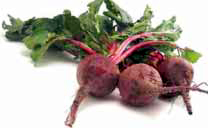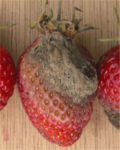 Apparently, Beyoncé hates beets.[1] And so do a lot of other people. I suspect this is because they have been eating canned beets. Canned beets are pale and watery next to the real thing. Real beets are so much redder, sweeter, and more flavorful. And they are a hot new vegetable, being made popular in the US by four-star chefs at tony restaurants in DC and Manhattan. Who knew? At the supermarket, I never see them in anybody's basket but my own.
Apparently, Beyoncé hates beets.[1] And so do a lot of other people. I suspect this is because they have been eating canned beets. Canned beets are pale and watery next to the real thing. Real beets are so much redder, sweeter, and more flavorful. And they are a hot new vegetable, being made popular in the US by four-star chefs at tony restaurants in DC and Manhattan. Who knew? At the supermarket, I never see them in anybody's basket but my own.
Why don't I see more people buying fresh beets? Do they not know what to do with them? Are they afraid they are too hard to prepare? Do they think they hate beets? I learned my mother-in-law thought she was not fond of beets when I served her a simple beet dish I learned from Julia Child ("Julia and Jacques Cooking at Home"). She had grown up on watery canned beets, and could only tolerate them prepared Harvard style -- plenty of sugar, vinegar, and cloves to make up for the missing flavors. She was amazed to find out how great beets can taste.
Most recipes begin by roasting the beets in a 350°F oven for an hour. And that is certainly delicious. The dry heat concentrates the flavor and the sweetness, and adds a little caramelization. But I don't always have the time, and, with the weather getting warmer, I don't always want to heat up my kitchen. So I follow Julia Child's advice -- I use the pressure cooker. A pressure cooker is a wonderful saucepot that speeds up cooking bean soups or whole hominy, but I use it much more these days for beets. Now that my grocery carries them all the time, I buy them practically every week. At 99 cents a pound, they are unbelievably cheap for something so delicious, so nutritious, and so beautiful. Pink fingertips seem a small price to pay.[2]
 You will need a serving bowl, a dishwasher-safe cutting board, your favorite knife, and a pressure cooker. Bring home some fresh beets -- I like the 3 to 5 inch beets best because their skins slip off so easily after they cook. You'll need half an hour to cook the beets, 10 minutes to cool them, and another 5-10 minutes to prepare them for the table. You could start a day ahead of time, and refrigerate the beets as soon as you can get the cooker open.
You will need a serving bowl, a dishwasher-safe cutting board, your favorite knife, and a pressure cooker. Bring home some fresh beets -- I like the 3 to 5 inch beets best because their skins slip off so easily after they cook. You'll need half an hour to cook the beets, 10 minutes to cool them, and another 5-10 minutes to prepare them for the table. You could start a day ahead of time, and refrigerate the beets as soon as you can get the cooker open.
Give the beets a quick rub-down in the sink. Cut off the greens just above the root. Save them to cook like chard. Snap off the tails. Don't cut into the beets -- they bleed. Add about an inch of water and a vegetable steamer to the bottom of the pressure cooker. Put the beets in, close up the pressure cooker, put the regulator on, and heat it up until the regulator starts regulating. Adjust the heat to keep the regulator happily spitting and hissing, cook for 30 minutes, then take the pot off the heat to cool down until the safety lock withdraws.
While the beets are cooking and cooling, prepare the rest of your meal. When practically everything else is ready for the table and the pressure cooker has cooled, open it and set up next to the sink. Get 3 or 4 beets out of the pot a time. They should be a little bit squishy. Slice off the tops, where the stems were attached. Trim out any hard spots and the edges of fissures. Using your fingertips, slip the skin right off into the bottom of the sink. It won't come off in one piece, but it should come off quickly. Underneath, the beet will look smoother and shinier than the dull skin. Slice the beets and tip them into the serving bowl.
I like a simple dressing, one that brings out the beet's natural sweetness and flavor. I have tried:
- garlic and kosher salt crushed in olive oil (Julia Child's recipe)
- olive oil and orange juice
- olive oil, balsamic vinegar, allspice, and vanilla, and a tiny pinch of salt
The third is my current favorite. Vanilla and allspice, balanced by the vinegar acidity bring out the sweetness without hiding the beet flavor. A very light coating of olive oil pulls it all together and enhances the mouth feel. This is as kid-friendly as Harvard Beets, but without the sugary syrup.
Once you master the beet basics, try something more sophisticated. Try roast beet, jicama, and carrot salad, or drizzle sliced beets with a blue cheese sauce.[3] On a typical weeknight, though, I stick with my standby. The kids eat it up, courtesy of Julia Child. Make plenty of extra, so your spouse can make Harvard Beets -- a fond childhood memory.
[1] Scholastic Star Spotlight -- Beyoncé[2] Well, pink fingertips and beeturia, a phenomenon you may never have observed if you have not eaten fresh beets. Do not be alarmed. It is merely the red beet color tinting your bodily fluids. I never see this when I eat canned beets, but I always see it when I eat fresh beets. [3] NPR: The Beet Goes On
Read all of "Fresh Beets, Simply" ...
 B was a meat and potatoes eater. One day, B said "I'm eating a lot more vegetables now". And, at my house, I noticed B WAS eating more vegetables, and trying new ones, too. Beets, broccoli, beans. All in all, a better-balanced diet -- a better balance of nutrients. B is thinking about a balanced diet, not weight loss, but replacing some helpings of meat and potatoes with lower-carbohydrate vegetables means fewer calories, too.
B was a meat and potatoes eater. One day, B said "I'm eating a lot more vegetables now". And, at my house, I noticed B WAS eating more vegetables, and trying new ones, too. Beets, broccoli, beans. All in all, a better-balanced diet -- a better balance of nutrients. B is thinking about a balanced diet, not weight loss, but replacing some helpings of meat and potatoes with lower-carbohydrate vegetables means fewer calories, too.











